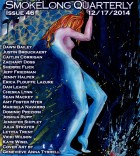Your main character, Miriam, puts an old photograph, a distinct memory of someone once loved, in the cup of her bra. At this point in the story, both she and the audience know that Death is creeping towards her, and I was left wondering: If Death snuck in with the cat, and I knew he was coming, what would I put in the cup of my bra? I’ve had some moderately important things in there, but, then again, I’ve never witnessed Death creeping around. So, my first question: What would you put inside your bra if you were about to die?
You know, I’ve never thought about this question of what would I take into the afterlife, or at least what would I hold dear in those final moments. This scene arises because Death knocks the frame to the floor and it breaks. Miriam has a choice between putting the broken frame back on the mantle or taking the photo out. Once the picture’s out of the frame, it only seemed natural that she would put it somewhere close, and for whatever reason, I have this idea that at some point, women get to an age where their brassieres are large enough to tuck things into. For me, then, the question is what might Death knock off my mantle or bookshelf. Right now, my mantle is mostly stocked with whatever I don’t want my two-year-old to get a hold of, but there’s also an ornament from her first year—a grouping of four family photos. Yeah, I’d say that if anything’s going in my bra, it would also be a photo of my wife and daughter.
In the beginning of your story, Miriam supposes that it would be polite to offer Death a drink of tea. I’m not sure what I would offer Death for a drink—maybe a nice brew or bourbon? What would you offer him (or her) and why?
Bourbon is a great idea. Yes, I might offer that but, honestly? I’m a pretty cheap bourbon drinker, and I would imagine that someone like Death has probably had just about the best bourbon around. What I have on top of my fridge is a peach bourbon that’s really kind of gross. So, not that. Actually, I would probably offer tea as well. I’m a tea drinker, as evidenced by the tea bags that pile up in my sink throughout the day. And with tea, it’s not quite the same faux pas as offering a shitty bourbon.
This story reminds me of Charles Simic’s poem, “Eyes Fastened with Pins,” where Death is personified as a lonely entity skirting about town, unappreciated in his work although not wholly understanding his purpose. In your story, the loneliness for both Death and the protagonist is subtler, but it’s there. Do you see a parallel to humanity and Death as a real entity?
Oh, yes, I imagine that Death is quite a lonely fellow, as are most people when they are about to die. Though Death and Miriam cannot bridge the gap of communication (although we don’t actually know if Death can’t communicate or simply chooses not to), there’s still a kind of companionship and camaraderie as they spend these final hours together. But also, within the story’s truth, Miriam is a sort of Seer; she can see Death and recognizes when Death arrives, whereas most others would pass over without realizing there was someone there with them all along. Miriam offers us the chance to consider that perhaps Death is a clumsy little fellow who sneaks in, accidentally breaks things, and eventually just wants a little snuggle. In the end, it’s Miriam who chooses to take Death’s hand. It’s her words that we hear at the end, her invitation to look both ways.
Did writing this story make you feel better about death?
Um, no. I still fear death, but that fear, I think, changes as the important things in my life change. Now, my fear is about my young daughter—what happens to her if I die? Fear of death is more often related to fears about what we leave behind, and this is still true for me. I don’t fear death in the sense of what happens afterward, but more for what I didn’t accomplish or the people that will be left behind. I would hope, though, that when I reach Miriam’s age, I will have the same blend of regret for the little things left undone, but a larger sense of happiness and connectedness to family and community.
Before Death takes her, Miriam requests that he let her finish a book. We do not know what the book is, but the ambiguity is essential because it simultaneously shows the small and large impending closures. What book would you be reading and why?
At first, I thought about this question and said, “How can I possibly know what I’ll be reading in forty or fifty years?” but then I realized that I know exactly what I’ll be reading. I’ll be reading Jane Austen because I’m pretty much reading her all the time. In fact, when my wife asks me what I’m reading on my Kindle and I say, “My sweater,” she knows it’s Austen. Reading Jane Austen is like putting on a beloved sweater, the elbows holey, a tear at the shoulder, a few cat hairs stuck to the back. You know the stories, you know the heroes from the villains, how it all ends, but there’s something comforting about falling back into words you know so well and finding new rhythms each time you read. Plus, because I have the complete works in one book on my e-reader, perhaps I could negotiate enough time to read them all before I have to say I’m done. Alternately, I’d be reading the thickest book in the house.



 The core workshop of SmokeLong Fitness is all in writing, so you can take part from anywhere at anytime. We are excited about creating a supportive, consistent and structured environment for flash writers to work on their craft in a community. We are thrilled and proud to say that our workshop participants have won, placed, or been listed in every major flash competition. Community works.
The core workshop of SmokeLong Fitness is all in writing, so you can take part from anywhere at anytime. We are excited about creating a supportive, consistent and structured environment for flash writers to work on their craft in a community. We are thrilled and proud to say that our workshop participants have won, placed, or been listed in every major flash competition. Community works.